
The Technik Museum Sinsheim is a technology museum in Sinsheim, Germany. Opened in 1981, it is run by a registered association called "Auto & Technik Museum Sinsheim e. V." which also runs the nearby Technik Museum Speyer.

The Eisenbahnmuseum Bochum-Dahlhausen is a railway museum situated south of the city of Bochum in the state of North Rhine-Westphalia, Germany. It was founded by DGEG, the German Railway History Company in 1977 and is based in a locomotive depot that was built between 1916 and 1918 and ceased operation in 1969. Then DGEG took over the whole area of 46,000 square metres and built up the biggest railway museum in Germany. In the middle of the museum, there is an engine shed with fourteen tracks. A preserved turntable, coaling, watering, and sanding facilities are still in operation. This museum is integrated into The Industrial Heritage Trail a route of monuments from the history of the industry.

The DBK Historic Railway is a preserved railway association in Crailsheim, Germany.

The Bavarian Class BB II engines were Mallet type, saturated steam locomotives in the service of the Royal Bavarian State Railways.
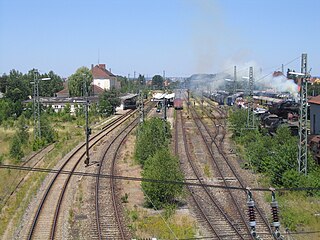
The Bavarian Railway Museum is a railway museum based in the old locomotive sheds at Nördlingen station in Bavaria, Germany. It is home to more than 100 original railway vehicles and has been located in the depot at Nördlingen since 1985.

The Nuremberg Transport Museum is based in Nuremberg, Germany, and consists of the Deutsche Bahn's own DB Museum and the Museum of Communications. It also has two satellite museums at Koblenz-Lützel and Halle. The Nuremberg Transport Museum is one of the oldest technical history museums in Europe.

The German Steam Locomotive Museum or DDM is located at the foot of the famous Schiefe Ebene ramp on the Ludwig South-North Railway in Neuenmarkt, Upper Franconia. This region is in northern Bavaria, Germany. The DDM was founded in 1977.
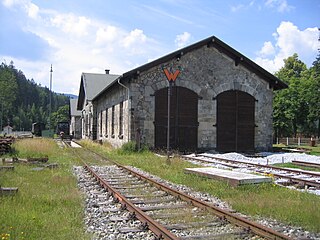
The Bavarian Localbahn Society, with its headquarters in Tegernsee, is a society that is concerned with the history of the railways in Bavaria. Localbahn means 'branch line' and is mainly used in southern Germany and Austria in lieu of the usual term Nebenbahn. The BLV's objectives are the operation of historic trains and the collection of historically valuable railway items from Bavaria.

The Mellrichstadt–Fladungen railway, also called the Streu Valley Line, is a Bavarian branch line that connects Mellrichstadt in Lower Franconia with the town of Fladungen, which nestles in the Rhön mountains.

The Neustadt/Weinstrasse Railway Museum is one of the two railway museums run by the German Railway History Company, or DGEG. It is located in the station at Neustadt an der Weinstraße. The other one is the Bochum Dahlhausen Railway Museum.

The Augsburg Railway Park is a railway museum in Augsburg on part of the former Augsburg locomotive shed owned by the Deutsche Bahn. Following reconstruction work, the park officially reopened on 13 April 2009. In the future, 29 historic locomotives from the EU member countries and also Switzerland will be exhibited in the roundhouse and on the turntable, the so-called Europa Roundhouse, which are protected historical buildings. In addition to the roundhouse there are also three historical steam locomotive halls with a workshop atmosphere and a historical smithy.

The Dampfbahn Fränkische Schweiz e. V. or DFS is a German museum railway operated by a registered society in Ebermannstadt, in a region of northern Bavaria, Germany, known as Franconian Switzerland.

The South German Railway Museum is a railway museum at Heilbronn in the state of Baden-Württemberg in southwestern Germany. It was founded in 1998.
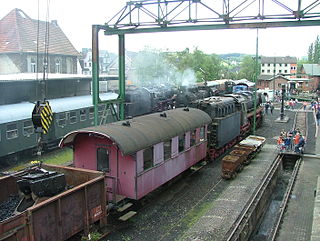
The Dieringhausen Railway Museum is a railway history museum in Dieringhausen in the district of Oberbergischer Kreis in North Rhine-Westphalia, Germany.

The Saxon Railway Museum is located in Chemnitz, in the state of Saxony, eastern Germany. It is situated on the site of the former locomotive depot for goods train locomotives in the district Hilbersdorf.

The steam locomotives of Class 23 were German passenger train locomotives developed in the 1950s for the Deutsche Bundesbahn. They had a 2-6-2 wheel arrangement and were equipped with Class 2'2' T 31 tenders. They were designed to replace the once ubiquitous Prussian P 8 engines that had been built between 1908 and 1924 and, in their day, were the most numerous post-war replacement class.
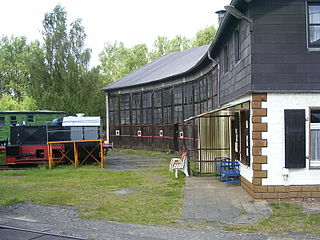
Bahnbetriebswerk Hermeskeil is a small, Prussian locomotive depot at Hermeskeil, in the state of Rhineland-Palatinate in Germany that dates from 1888. Until 1903, it was called a Maschinenstation.

The DB Museum in Koblenz was opened on 21 April 2001 as the first remote site of the Nuremberg Transport Museum. It is run by volunteer workers as part of the Stiftung Bahn-Sozialwerk (BSW), a kind of railway workers social service organisation, and has its origins in a BSW's 'Group for the Preservation of Historical Railway Vehicles' at Koblenz.
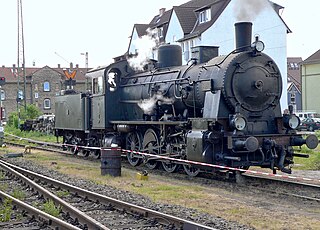
The Prussian Class G 8 locomotives were eight-coupled, superheated, freight locomotives operated by the Prussian state railways. There were two variants: the G 8 built from 1902 with a 14 tonne axle load and the "reinforced G 8" built from 1913 with a 17-tonne axle load. The latter was the most numerous German state railway (Länderbahn) locomotive, over 5,000 examples being built.



















